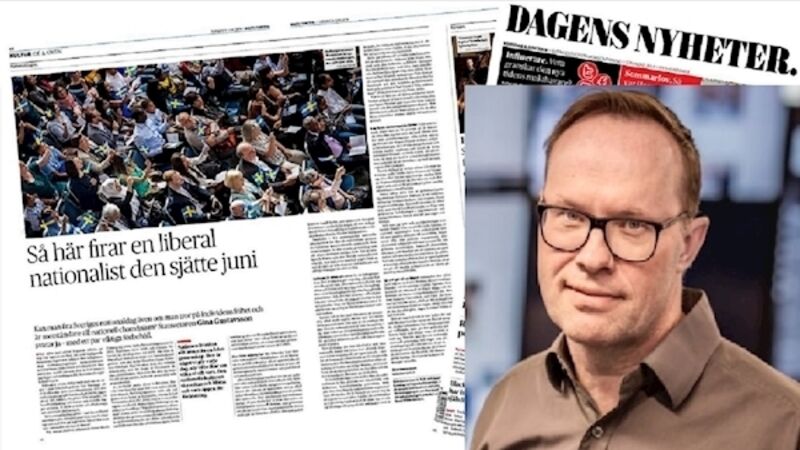GRAPEVINE: Covid-19 driving record levels of online news readership in Sweden

Digital subscriber numbers are soaring at Swedish daily newspaper , where readers have been steadily migrating to online in recent years.
In the few months since the outbreak of Covid-19, around 150,000 people have signed up as free subscribers to access DN’s entire online content until the end of May, joining the near 310,000 existing paying subscribers availing of DN’s comprehensive content, the bulk of which is kept behind a paywall.
Such is the loyalty of DN’s readership, not one of the core subscribers has objected to paying for content which the new arrivals are accessing free of charge, in exchange for which they have given DN their emails and contact numbers.
“These free subscribers are leads that we will hope to convert to paying customers later on,” said Martin Jonsson, head of editorial development at .
Mr Jonsson was the guest speaker at a webinar hosted by WAN-IFRA, the World Association of Newspapers and news publishers. The audience members were all media people.
“We have previously offered new readers free access during general elections and the terrorism attacks in Stockholm. Those offers were just for a few days. This time the offer is for much longer, at least six or seven weeks.
“In the past, we have had a conversion rate of about 40% after a free offer. Of those conversions, around 75% were completely new customers. If we convert around 25% from the current free offer, it would mean gaining around 30,000 new subscribers.
“Today, we have around 460,000 subscribers, between paid and unpaid, which is a record for DN. We are confident that we will convert a lot of our new readers into paid subscribers. People want quality journalism and they realise that this involves a cost.”

Swedes see value in subscribing for quality news content
The advent of Covid-19 has brought a clear message to Swedish people as regards the value of in-depth quality journalism. ’s digital transformation over the past five years is now proving to be a solid foundation for its current growth spike, fuelled by the huge reader interest in reliable information on the coronavirus pandemic.
Of course, it’s worth noting that media content producers, like any other business, are under serious pressure from Covid-19. has had to put 20% of its staff on temporary layoff.
More than 90% of DN’s newsroom staff are now working from home. While at one level it owes its readership growth to interest in quality reporting on Covid-19, the virus is as much a threat to media as it is to every other sector.
“We know that we need to do our best possible journalism at this time, and yet we must also cut costs,” said Mr Martin Jonsson.
“A vital part of what we are currently doing is telling our new readers that quality journalism is a costly business. We are trying to reach as many people as possible, but we are now also quickly moving people on to pay for the deeper content.”
DN's strategy evolved as Covid-19 trends became clear
DN ran its first article on coronavirus on January 11 — then a story about a remote virus in China. From then to the WAN-IFRA webinar on Tuesday, April 14, DN had run 2,024 more stories with a coronavirus tag.
The publisher introduced paywall changes on February 28 for selected content; even though all articles with a coronavirus tagline were still freely open to all readers. By March 2, almost all content was carrying a Corona the tag.
“We are careful not to be too generous to our free subscribers. We must remain conscious of our existing paying subscribers. That said, most people understand that the virus is a crucial topic that we need to make broadly available.”
Online traffic is jumping 100% daily, 125% some days. In recent weeks, traffic is up 400% on its online video channels. Traffic is also soaring across its social media referrals and newsletters.
DN reports around 6 million to 7 million pageviews weekly across all traffic. While its surge in new readers is clearly driven by an appetite for quality reporting on the virus, DN has also seen a 30% leap in non-Coronavirus stories.
The current focus on Covid-19 offers a useful insight into how DN draws a line between free and paid-for content. It gives all readers access to all core ‘big picture’ news stories; eg. starting with all public service stories from the Department of Health.

General news is free; in-depth coverage is behind a paywall
DN is putting its columnists, specialist writers, and guest experts behind its paywall. While it has currently laid off some staff temporarily, it has also invested in a lot of new journalists in recent years; and it has brought in more experts and specialists.
“Our focus is on quality and making sure that people seeking in-depth reporting find it with us,” said Martin Mr Jonsson. “Our KPI is the length of time which people spend on every story. That is the metric that proves we are producing the quality content that others don’t.”
During the webinar, Mr Jonsson replied to questions on aspects of ’s marketing strategy, like the free access it offers to students, the fact that DN does not really engage in content sharing, the tools it uses to on-board certain target categories of reader, and how its messages have changed over the five years in which its transformation from print to digital has been evolving.
“If this virus had happened five years ago, we would have been hit much harder,” he said. “From 2015-19, we have gone from being a print legacy newspaper to primarily an online publisher.
“In that time, our paying digital-only reader numbers have grown by 182%. Our business is 70% based upon reader revenue. We could not function without a paywall. We employ around 210 journalists. We had around 1.1m daily readers prior to Coronavirus — we’re now at 1.6m daily readers.”
Webinar poll shows all media outlets gaining
During the webinar, WAN-IFRA invited participants to complete a single-question poll on the extent of their newspaper's gains in online subscribers since the outbreak of Covid-19.
- 19% of attendees saw zero gain in their subscribers;
- 25% were up by 10-20%;
- 18% were up 20-30%;
- 7% were up 30-40%;
- 13% were up 40-50%;
- and 17% saw gains of over 50%.
The Group members, including , and others, have also seen welcome gains in online subscriber numbers, a surge in online pageviews, along with increases in home deliveries and other customer services.
These gains, however, are only partially offsetting the losses caused by the negative impacts of Covid-19. As the temporary layoffs at have shown, those working in the media are every bit as focused as other sectors on life after the virus.
The future for media was also a key focus for people attending the webinar, which ended with a question on when the management at DN think their staff might return to the office.
“We don’t expect people to be back in the newsroom before June, maybe even longer for some staff,” said Mr Jonsson. “The restoration of normality is still some way off.
“When we look back at this period, the main gain we will see is that so many people will have taken a big leap forward in digital. We are trying to be very dynamic with our content. This is a quick experiment, opening up our digital content to everyone.”





